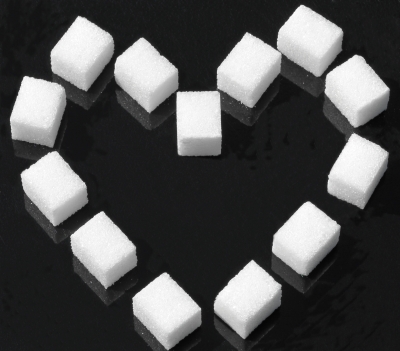High Fructose Corn Syrup or Table Sugar: Which is Better?

Do you think of honey or agave nectar as being more “natural” than other types of sweeteners? You might be surprised to learn that most sweeteners go through very similar forms of processing.
High fructose corn syrup, fruit juice concentrate, table sugar (sucrose), and agave nectar all undergo extraction, filtration, enzyme treatment, and concentration.
Since processing methods are similar between these types of sweeteners, don’t assume you need to select one over another because one is more “natural” or less processed.
Digestion and Absorption of Table Sugar vs. High Fructose Corn Syrup
The molecular structure of table sugar (sucrose) and high fructose corn syrup do differ; however, this difference is eliminated in the small intestine when the glucose-fructose bond in sucrose is broken. Therefore, once the two sweeteners reach the blood stream any difference has been eliminated.
When they reach the blood stream they are providing the same sugars at the same ratios to the same tissues/organs within the same time frame.
Despite the similarity in digestion and absorption, media coverage might have you questioning potential health concerns related to fructose and high fructose corn syrup. This steams from the possibility of small percent, ~3-5%, of fructose being converted to fatty acids in the liver.
Nutritional Value of Corn and Heart Health
 I recently listened to an interesting conversation related to corn. It was more a debate on corns’ status as a vegetable, lack of nutritional value of corn, and link to health problems (specifically diabetes and obesity). It was proposed that corn should be banned from production. The debate went on to suggest a comparison between corn and tobacco production and their similar impact on our society. Now, I am hoping some of this was argument just for arguments sake. What did this little yellow kernel ever do? I am stepping up in its’ defense.
I recently listened to an interesting conversation related to corn. It was more a debate on corns’ status as a vegetable, lack of nutritional value of corn, and link to health problems (specifically diabetes and obesity). It was proposed that corn should be banned from production. The debate went on to suggest a comparison between corn and tobacco production and their similar impact on our society. Now, I am hoping some of this was argument just for arguments sake. What did this little yellow kernel ever do? I am stepping up in its’ defense.
If you want to delve into botany, you could argue that corn is a grain; but I am not going to go into that explanation. In our society, corn is eaten like a vegetable. Granted it is a starchy vegetable, but a vegetable nonetheless. As far as nutritional value, ½ cup of frozen corn contributes some Vitamin A and potassium, 2 g of dietary fiber, 2.5 g of protein, only 1.5 g of sugar and less than 0.5 g of fat. The nutritional value is not outstanding, but not terrible either.
Corn is a whole grain and includes resistant starch. Resistant starches are popping up as a hot topic related to weight loss. A resistant starch is a type of fiber that resists digestion and passes through the small intestine to the large intestine mostly intact. In the large intestine it ferments and produces a fatty acid (bytyrate) that reduces toxins and helps protect against digestive diseases. Resistant starches boost immunity, improve blood sugar control, and increase satiety (a plus for individuals trying to lose weight).
Cornmeal, Corn starch, Popcorn, High Fructose Corn Syrup
Corn is used in the production of many products. I am going to briefly cover just a couple – cornmeal, cornstarch, popcorn, and high fructose corn syrup – none of which are vegetables.
Cornmeal versus cornstarch is comparable to whole wheat flour versus white flour. Cornmeal includes the whole corn grain (bran, germ, and endosperm) while cornstarch is refined (bran and germ removed). Whole grain equals a good source of dietary fiber.
Popcorn is an excellent snack that is low calorie. Of course, you need to watch the added butter and salt. One cup of light popcorn equals ~15 calories and provides 5 g of dietary fiber!
High fructose corn syrup is a major ingredient in soda and numerous foods with a low nutritional value. To produce high fructose corn syrup, whole corn is refined to corn starch. This corn starch is then processed with enzymes to yield a glucose and fructose mixture, eventually resulting in the production of high fructose corn syrup. To say that high fructose corn syrup is corn is like saying Sunny Delight is orange juice.
Glycemic Index
The glycemic index is an oft times used rationale supporting the argument that corn is bad, based on how quickly corn raises blood sugar levels. It has been well-known for years that the glycemic index is not a reliable tool. If you were to base eating on the glycemic index, that would mean you sit down for your evening meal and dine on a cup of corn only. How likely is that? A typical meal includes a variety of foods, such as some meat and bread, along with corn. The protein, fiber, and other components of these various foods, negate the glycemic index value established for corn alone.
Portion Control
I sincerely doubt someone is overweight because they couldn’t put down the corn. Corn does provide ~80 calories per half cup, so as with everything else, you need to practice portion control and watch what you add. A tablespoon of butter added to a half cup of corn increases the calorie count to ~180 calories.
Bottom Line:
If you like corn, eat it. You do receive a nutritious vegetable, but watch the amount. Definitely NOT the root of all evil!
All the best,
Lisa Nelson RD
Be Heart Healthy and Lose Weight



